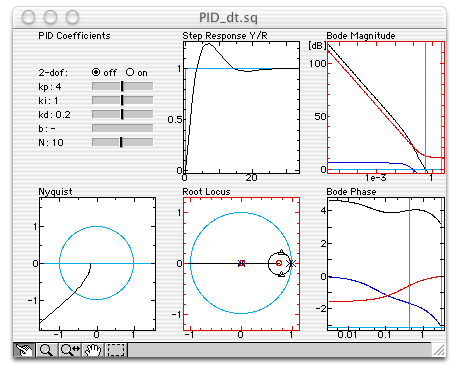Sysquake Pro – Table of Contents
Sysquake for LaTeX – Table of Contents
PID_dt.sq
Discrete-time PID controller
The PID controller is fundamentally a continuous-time controller.
However, it is often implemented with digital electronic devices
(such as microcomputers, microcontrollers, or FPGA). Sampling effects
may change performance in subtle ways, especially when the
sampling frequency is not very high with respect to the bandwidth of
the controlled system. Instead of converting a continuous-time PID
controller, it is possible to design a PID directly in the discrete-time
domain, approximating the integration and derivation by sums and
differences, respectively. The parameters of the PID keep their
standard meaning. PID_dt.sq does for discrete-time PID controllers
what PID_ct.sq does for continuous-time PID controllers
![]()
where

Like the continuous-time PID controller, the discrete-time controller is usually not implemented like this: the derivative term is not applied to the set-point, the proportional gain is reduced for the set-point, and the derivative action is filtered. The transfer function used for feedback is
![]()
Figures
The figures are the same as those defined for RST_dt.sq, except for the Open-Loop Zeros and Poles and the Closed-Loop Poles which are not defined.
Settings
The System (continuous-time model), System (discrete-time model), Sampling Period, and Damping Specification have the same effect as the corresponding menu entries defined in RST_dt.sq. Two new entries are defined.
PID Coefficients
The three parameters of the PID (
No Derivator On Reference
When the input of the PID controller is the error between the set-point and the measured output, discontinuities of the set-point are differentiated by the derivator component of the PID and yield infinite values (or very large values in the case of a discrete-time PID controller) for the control signal. To avoid that, the set-point is usually not differentiated. The control signal is

Display Frequency Line
When selected, moving the mouse above a frequency response (Bode or sensitivity) will display a corresponding line in other frequency responses, Nyquist diagrams, and zero/pole diagrams.